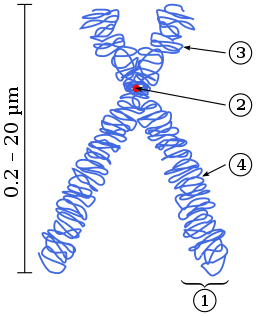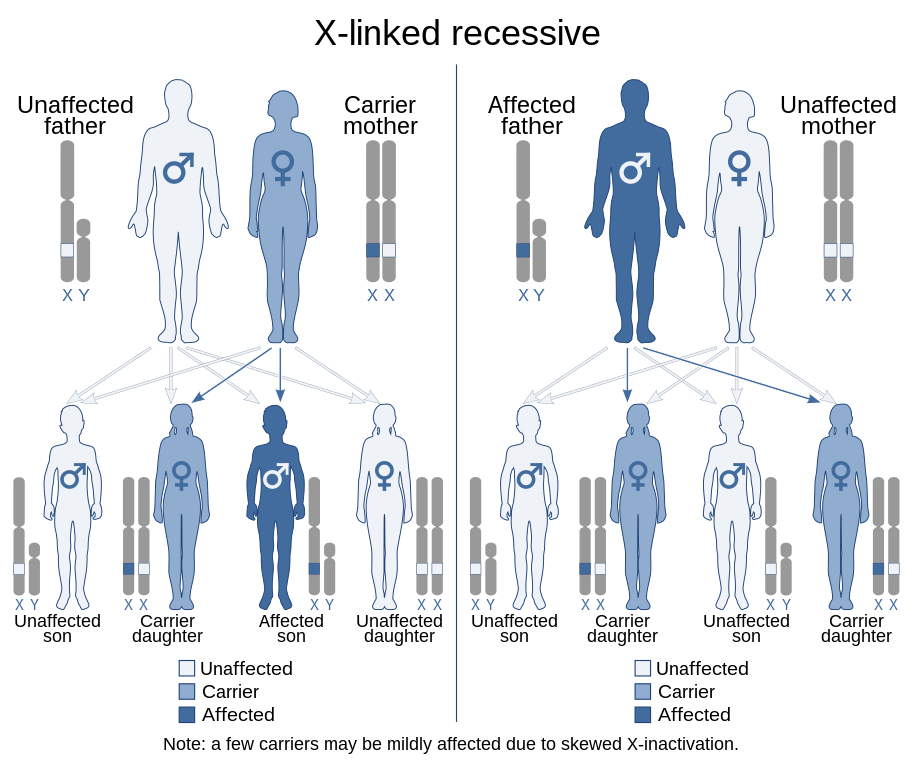
What is X-linked recessive inheritance?

The X chromosome contains many genes that are important for growth and development. The Y chromosome is quite smaller and contains fewer genes. Females have two copies of the X chromosome (XX), thus, if one of these genes has an abnormality, the normal gene on the other chromosome will compensate for the mutated copy. If this occurs, this woman will be healthy but a carrier of the disease linked to the X chromosome.

Being a carrier means that you do not have the disease, but you do have a copy of the mutated gene. In some cases, women show mild symptoms of the disease. Men have an X chromosome and a Y chromosome (XY), therefore, if one of the genes on the X chromosome has an alteration, they do not have another correct copy of the gene to compensate for it. This means that they will be affected by the disease.
Diseases that are inherited this way are called X-linked recessive diseases. Some examples of these diseases are hemophilia A and Duchenne muscular dystrophy.
How are X-linked recessive diseases inherited?
If a female carrier has a son, he will inherit the X chromosome with the correct gene or the X chromosome with the altered gene. This woman's sons, therefore, will have a 50% chance (1 in 2 chance) of inheriting the mutated gene and developing the disease. On the other hand, there is a 50% chance (1 in 2 chance) that the child will inherit the normal gene. If this happens, he will not be affected by the disease. Each son will have the exact same probability of inheriting the correct or the mutated gene.
If a female carrier has a daughter, she will inherit the X chromosome with the normal gene or the X chromosome with the mutated gene. Therefore, each daughter wll have a 50% chance (1 in 2 chance) of inheriting the mutated gene. If this happens, the daughter can be a carrier, like her mother.
On the other hand, there is a 50% chance (1 in 2 chance) that the girl will inherit the normal gene. If this happens, she will not be a carrier and will not be affected by the disease. This probability is the same for each daughter.
If a man has a disease linked to the X chromosome, he will always transmit the mutated gene to his daughters. This happens because the man only has one X chromosome, which is the one that determines the female sex when it is inherited. All his daughters, therefore, will be carriers, that is, they will not develop the disease, but they are at risk of having affected children. If a man with an X-linked disease has a son, he will never inherit the mutated gene (located on the X chromosome). This is because men always pass on the Y chromosome to their sons (if they did pass on the X chromosome they would have a daughter).

What happens when a child is the first person in the family to have the disease?
Sometimes a newborn with an X-linked genetic disease is the first person in the family to have that disease. This may occur when the mutation is new (de novo mutation), this is it occurs during the formation of the egg or sperm that gave rise to the baby. When this occurs, the parents of the child do not have the disease and it is unlikely that they will have another child with the same disease. However, the affected child has the mutated gene and can pass it on to their offspring.
Carrier testing and test during the pregnancy
The are several options available for people with a family history of X-linked genetic disorders. Carrier testing is available for women who want to know if they carry an X-chromosome gene alteration. This information can be helpful when planning a pregnancy. For some X-linked diseases, they can undergo a specific test during pregnancy to see if the baby has inherited the disease.
We recommend to discuss this issue with a geneticist, as her or she will offer suitable advice regarding the type of inheritance thar needs to be analysed and the tests that should be carried out.
Things to bear in mind
- Female carriers have a 50% chance of passing the mutated copy of the gene to their offspring. If a son inherits a mutated gene from her mother, he will be affected by the disease; however, if a daughter inherits the mutated gene, she can be a carrier and not develop the disease, like her mother.
- A man who has an X-linked disease will always transmit the mutated gene to his daughter, who will develop the disease if it is dominant or will be a carrier if it is recessive.
- A man will never transmit the mutated gene to his son if he is linked to the X chromosome.
- A genetic mutation cannot be corrected. It is present throughout life.
-
A genetic mutation is not something that can be spread to another person. Thus, a carrier of a genetic mutation can be, for example, a blood donor.
